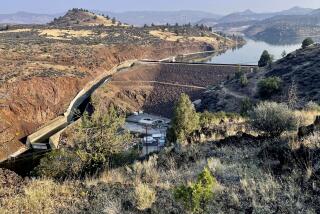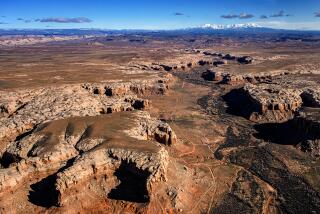Where the Buffalo Roam Again : Bison’s return to the prairie after a 120-year absence is part of a conservationist effort to restore the tall grasses.
- Share via
PAWHUSKA, Okla. — Bison returned to the Tallgrass Prairie Monday after a 120-year absence, thundering through an open holding pen gate onto the largest unbroken tract of native grassland in the United States.
Spectators in viewing stands fell silent, struck by a sight from the nation’s past. Then they broke into cheers as the 300 galloping buffalo lowered their heads and disappeared into a horizon of golden grass.
The moment marked a critical turning point for the Nature Conservancy, which bought the land for the 36,000-acre Tallgrass Prairie Preserve and is campaigning to restore more of the prairie that once stretched across 142 million acres of the nation’s midsection from Texas to Canada.
“Reintroduction of bison to the Tallgrass Prairie will help bring back the natural forces that allowed the prairie to evolve and thrive,” said Harvey Payne, director of the project. “No one ever dreamed we’d be able to roll the clock back and see what the settlers saw.”
The bison, donated by a rancher, will initially live on 5,000 acres of land. Eventually 1,800 head will roam on 30,000 acres, their movements monitored by microchips embedded behind their ears.
The Nature Conservancy, the nation’s largest private land conservation organization, bought 30,000 acres of a local ranch in 1989 for $8 million, then purchased additional acreage, bringing the $15-million project to 36,000 acres.
To prepare for the starter herd, conservationists burned 24,000 acres in March, simulating the wildfires once caused by lightning or Indian encampments. “Fires are necessary for the prairie ecosystem because it clears the undergrowth so that new plant life can grow,” Payne said.
The hardy native prairie plants, with roots up to 15 feet deep, quickly recovered from the fire, and new shoots sprouted through the ash within days.
Scientists hope the farm-raised bison will behave as their ancestors did and graze on the regrowth, leaving the dry, older plants for the next burning season.
The prairie used to be so thick with wildflowers and chest-high grass that settlers heading west could lose children in it. But its dark, nutrient-dense soil made the prairie “simply too rich to endure,” wrote author John Madson. By the turn of the century, the buffalo herds that once numbered 60 million had been slaughtered and the wild grassland was plowed under and transformed into geometric rows of Corn Belt crops.
Less than 10% of the pre-settlement prairie remains, much of it in two tracts in northeastern Oklahoma and Kansas, where the soil was too rocky to be tilled.
In 1872, the federal government turned the unplowable land in Oklahoma into a reservation for the Osage Indians, who eventually sold nearly all of it to ranchers, while reserving the mineral rights to the oil discovered in 1893.
The Osage fought federal efforts in the mid-1980s to turn some of the land into a national park, knowing the park service would not allow oil drilling. But the Nature Conservancy said it would permit some drilling.
Today the preserve is luxuriant with tall grasses and delicate prairie flowers. Tourists can see seven-foot-tall big bluestem, blazing stars and pink prairie orchids in the fall. Next spring, the acacia will come up and the air will be sweet with the scent of wild roses.
“This is a gift for future generations . . . the great-grandchildren of the children here today can see what our great grandparents saw,” said Gen. H. Norman Schwarzkopf, a member of the conservancy’s board of governors.
About 100 Osage watched the bison release, some listening to the hoofbeats.
“To see the herd back on the prairie, it brings to life the tribal stories told by our elders,” said Geoff Standing Bear, 40, assistant principal chief and an attorney. “There’s something here that stirs you.”
More to Read
Sign up for Essential California
The most important California stories and recommendations in your inbox every morning.
You may occasionally receive promotional content from the Los Angeles Times.













